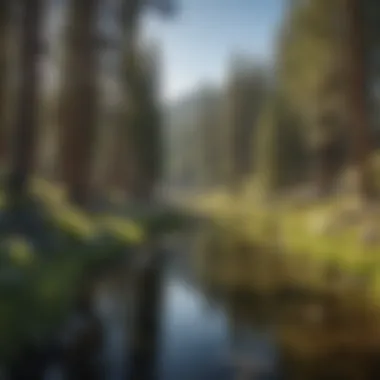Discover Truckee's Campgrounds: A Complete Guide


Intro
The campgrounds in Truckee, California, offer a unique blend of natural beauty, recreational opportunities, and ecological importance. Nestled in the Sierra Nevada range, Truckee is not just a destination for outdoor enthusiasts. It serves as a critical habitat for various species, making its understanding vital for sustainable practices. The geographical diversity within this region affects the types of campgrounds available and the experience each offers.
This comprehensive guide explores the campgrounds in Truckee while emphasizing the need for environmental stewardship. It caters to individuals and groups with an interest in sustainable camping practices. Insight into amenities, local attractions, and camping regulations helps readers make informed decisions about their trips. Additionally, understanding the underlying ecological frameworks allows campers to appreciate the landscapes surrounding them.
Forest Ecology and Biodiversity
Importance of Forest Ecosystems
Forests play a crucial role in maintaining ecological balance. They serve as carbon sinks, help in soil conservation, and support diverse wildlife. In Truckee, the interplay between various forest ecosystems creates a rich tapestry of habitats that are essential for both flora and fauna.
These ecosystems contribute to water purification and climate regulation, directly impacting the quality of life for local inhabitants and tourists alike. Campers who engage with these environments should do so with an awareness of their significance and necessity for protection.
Flora and Fauna in Woodlands
The woodlands surrounding Truckee aren't merely scenic backdrops; they are home to an array of plant and animal species. Some notable flora includes:
- Jeffrey Pine
- White Fir
- Sagebrush
- Wildflower species in spring
The fauna thrives under these trees, featuring a selection of noteworthy species:
- Mule Deer
- Black Bears
- Various birds including the Mountain Bluebird
By understanding these species and their habitats, campers can foster a deeper connection with nature, enhancing their overall experience while ensuring responsible camping practices.
"Understanding the local ecosystem is key to responsible outdoor activities, ensuring these natural resources endure for future generations."
Sustainable Forestry Practices
Techniques for Responsible Management
Promoting sustainability in a camping context requires knowledge about responsible forest management techniques. Techniques such as selective logging and controlled burns can minimize ecological disruption. These practices maintain forest health while allowing for recreational use.
Additionally, employing Leave No Trace principles during camping helps maintain the pristine condition of these environments. Campers should pack out what they carry in and minimize campfire impact to protect soil and vegetation.
Certification Schemes and Standards
Organizations like the Forest Stewardship Council (FSC) ensure that timber and forest products come from responsibly managed forests. Campers can choose campsites that follow such certification schemes. Seeking locations recognized for environmental accountability also showcases a commitment to conserving natural resources.
Community Engagement and Stewardship
Role of Local Communities
The residents of Truckee actively contribute to maintaining the health of their natural surroundings. Many local organizations focus on conservation efforts and promote sustainable outdoor practices. By collaborating with these groups, campers can engage with the local community and learn about ongoing environmental initiatives.
Volunteer Opportunities for Engagement
Camping in Truckee also provides numerous volunteering options. Engaging in forest clean-ups, wildlife monitoring, or habitat restoration projects allows visitors to give back. Connecting with organizations such as the Truckee Donner Land Trust can enhance the experience, ensuring the natural beauty of the area is preserved.
In sum, exploring the campgrounds in Truckee transcends mere recreation. By understanding and respecting the intersecting realms of ecology, forestry practices, and community engagement, visitors can become stewards of the remarkable environments they enjoy.
Prolusion to Truckee Campgrounds
Truckee, California, situated in the stunning Sierra Nevada mountains, is a prime location for outdoor enthusiasts. Its campgrounds are not mere sites for pitching tents; they present unique experiences rooted in nature and community. Understanding the significance of these campgrounds is crucial for anyone interested in exploring this region.


The campgrounds in Truckee serve various purposes, offering something for everyone from casual campers to seasoned adventurers. Each campground has its own distinct characteristics, amenities, and benefits that cater to different preferences.
Among the many reasons to camp in Truckee, the access to pristine natural environments and diverse recreational activities stands out. Visitors can engage in hiking, fishing, or simply enjoying the serene landscapes.
Key points to consider include:
- Variety in Camping Experience: From primitive sites to more developed campgrounds, the options cater to different comfort levels and needs.
- Connection to Nature: Spending time in these campgrounds fosters a deeper appreciation for the local ecosystems.
- Community Building: Many campgrounds facilitate gatherings and create a sense of community among campers.
Choosing to camp in Truckee not only supports personal well-being but also encourages environmental stewardship. Campers are reminded of their role in preserving the beauty they seek to enjoy, promoting sustainable practices throughout their stay.
"Exploring Truckee’s campgrounds provides an opportunity to connect with both nature and a vibrant community of outdoor enthusiasts."
In summary, the campgrounds in Truckee are essential to the region’s outdoor culture. They offer meaningful connections to nature, promote sustainable practices, and enhance the overall experience of camping. Understanding their significance leads to more informed and enjoyable camping adventures.
Geographical Context of Truckee
Understanding the geographical context of Truckee is essential for appreciating its unique campgrounds and their surrounding ecosystems. The town, located at a high elevation in the Sierra Nevada mountains, serves as an access point to numerous outdoor recreational opportunities. The geographic features create distinct environments that influence everything from vegetation to wildlife activity. This section explores the meaning and significance of Truckee's location, in addition to its topographical attributes and climate conditions.
Location and Accessibility
Truckee is strategically situated approximately 30 miles west of Reno, Nevada, and 100 miles northeast of Sacramento, California. This central location makes it reachable via several highways, primarily Interstate 80, which connects the area to larger urban centers. Moreover, the town's proximity to Lake Tahoe adds another layer of accessibility, attracting visitors year-round. Various transportation options, including public buses and rail services, enhance its connectivity, making it convenient for both day-trippers and long-term campers to explore the region.
The accessibility is not just physical; it also opens doors to numerous recreational activities, greatly catering to campers and outdoor enthusiasts. The presence of nearby amenities, such as grocery stores and rental shops for outdoor gear, further simplifies the camping experience for visitors.
Topography and Climate
The topography of Truckee is characterized by its mountainous terrain, with elevations ranging from about 5,300 to more than 7,200 feet above sea level. This elevation contributes to diverse ecosystems within its campgrounds, each offering unique flora and fauna. The area is mostly covered with coniferous forests, including species such as Jeffrey pine and red fir, which are vital to the local environment.
The climate in Truckee is marked by cold winters and mild summers. Winter temperatures can plunge below freezing, while summer days often reach comfortable highs around 80 degrees Fahrenheit. This climatic variability supports different camping seasons. Campers seeking winter sports can enjoy snowshoeing and cross-country skiing, while those eager for summer activities may engage in hiking and fishing.
The climatic conditions also bring attention to the need for ecological awareness; temperature shifts can impact local wildlife and plant life.
In summary, the geographical context of Truckee—its location, accessibility, topography, and climate—is fundamental not only for navigation but also for understanding the ecological dynamics. This knowledge can enhance the camping experience, encouraging responsible engagement with nature.
Categories of Campgrounds
Understanding the different categories of campgrounds is essential for both seasoned campers and newcomers in Truckee. Each category serves specific needs and preferences, making it important to identify which type suits individual requirements best. The primary categories include Forest Service Campgrounds, Private Campgrounds, and RV Parks. Each type has unique characteristics, levels of amenities, and access to recreational activities.
Recognizing the distinctions helps campers choose suitable options based on their interests, whether they prefer secluded natural settings, amenities of a private campground, or specialized facilities for RVs. Additionally, this understanding aligns campers with wider ecological considerations and sustainable practices, ensuring a minimal impact on the environment.
Forest Service Campgrounds
Forest Service Campgrounds in the Truckee area primarily reflect the natural beauty of the surrounding Sierra Nevada. Managed by the United States Forest Service, these campgrounds often emphasize a rustic camping experience.
These campgrounds offer basic amenities such as picnic tables, fire rings, and access to restrooms. However, facilities may vary from one campground to another. Their proximity to hiking trails, lakes, and rivers enhances the outdoor experience significantly, appealing to nature enthusiasts.
Given their often remote locations, it is critical for campers to come well-prepared. Access to fresh water may not always be available, thus ensuring sufficient supplies is important. Visitors will find that these sites invite exploration of trails and wildlife watching, adding to their appeal.
Some popular Forest Service Campgrounds include:
- Prosser Campground
- Boca Campground
Private Campgrounds
Private campgrounds in Truckee cater to those seeking more comfort and convenience. Often located close to towns, these campgrounds offer a range of amenities, including power hookups, showers, and laundry services. These features can greatly enhance the camping experience, making it more accessible for families, seniors, and those less inclined to rough it in nature.
Many private campgrounds also provide additional activities, such as organized events, recreational equipment rentals, and easy access to local attractions. This makes them an ideal choice for campers looking for social interaction or specific amenities during their stay.


Families may appreciate private campgrounds for their kid-friendly facilities, such as playgrounds or swimming pools. However, it is worth noting that these campgrounds come at a higher price point compared to their public counterparts.
RV Parks
RV Parks in Truckee serve a specific niche within the camping landscape, catering to those who travel in recreational vehicles. These parks often provide full service connections, including electrical, water, and sewage hookups. Many RV Parks offer extensive amenities, including Wi-Fi access, dump stations, and laundry facilities, enhancing the travel experience for individuals and families.
The convenience of RV Parks appeals to those who prefer to travel comfortably while still enjoying the outdoors. Many RV Parks feature sites designed for short-term or extended stays, allowing for flexibility in the duration of visits. Some also provide recreational opportunities like proximity to hiking trails or lakes for fishing.
The presence of RV Parks can help bridge the gap between traditional camping and more developed accommodation options, making outdoor experiences accessible to a wider audience.
Key Campgrounds in Truckee
The campgrounds in Truckee play a vital role not only in supporting recreational activities but also in bolstering the local economy. By offering diverse experiences, these campgrounds cater to a wide range of visitors—from families to solo adventurers, all seeking the tranquility of nature. Understanding the details of these campgrounds can enhance visitor preparedness and enjoyment, ensuring responsible interaction with the local environment. Each campground provides unique benefits and considerations, making a thorough examination essential for anyone looking to explore this beautiful region.
Donner Memorial State Park
Overview
Donner Memorial State Park is notable for its historical significance and scenic beauty. This park offers a deep insight into the tragic events of the Donner Party and serves as a memorial to their hardship. The park blends natural beauty with history, making it a beneficial choice for visitors interested in both leisure and learning. Its unique feature lies in its well-preserved historical sites, providing an enriching experience that few other campgrounds can offer.
Amenities
The amenities available at Donner Memorial State Park enhance the camping experience. Facilities include picnic areas, restrooms, and well-defined hiking trails. These aspects make it a convenient and popular choice for families and casual campers. However, the park's popularity sometimes leads to higher traffic, which can affect the serene atmosphere that nature lovers seek.
Nearby Attractions
Nearby attractions include historic sites and natural wonders, such as Donner Lake and the summit tunnel. These features attract visitors with various interests, from history buffs to outdoor enthusiasts. The blend of activities available enhances the appeal of the campground. However, proximity to these attractions can also draw larger crowds, posing challenges in maintaining a peaceful camping environment.
Tahoe National Forest Campgrounds
Overview
The Tahoe National Forest offers an extensive range of campgrounds, presenting a variety of environments from lakeside settings to forest edges. Each site varies in amenities and accessibility, catering to different types of campers. The unique characteristic of this forest is its vastness, providing plenty of choices for anyone seeking solitude or adventure. However, the expansive area can cause confusion for first-time visitors regarding navigation and campground selection.
Amenities
Amenities across Tahoe National Forest campgrounds are generally straightforward. Most sites feature basic necessities such as fire rings, tables, and toilets. Some developed sites offer additional services like showers and garbage collection. This variety allows campers to select locations that best fit their comforts and needs. Limited amenities at more remote sites can deter some, though others appreciate the unadulterated experience.
Recreational Activities
Recreational activities in the Tahoe National Forest are plentiful. Popular options include hiking, fishing, and biking. The diverse landscape provides opportunities for exploration and adventure. Uniquely, the forest also offers winter sports in colder months, such as cross-country skiing. However, the seasonal change may affect accessibility, requiring advanced planning for visitors.
Sierra Novelties Campground
Overview
Sierra Novelties Campground is characterized by its family-oriented atmosphere and accessible location. This campground stands out for its community vibe, making it a welcoming space for families and groups. Its unique feature is the emphasis on community interaction, creating memorable events that foster a sense of connection among campers. However, such a focus on community can sometimes lead to noise disturbances, which may not appeal to all campers.
Facilities
Facilities at Sierra Novelties include a playground, store, and organized events throughout the camping season. These amenities greatly enhance the experience by offering entertainment and convenience. For families, this makes it an ideal choice, as children can engage in various activities. However, the type of facilities may not align with all campers' desires, especially those looking for a more rustic experience.
Community Events
Community events hosted at Sierra Novelties are a key attraction. These include campfire storytelling, themed weekends, and group hikes. Such events enrich the camping experience and promote sociability among visitors. However, the focus on events may deter those seeking solitude, as the area can become bustling during popular gatherings.
Ecological Considerations


Understanding the ecological considerations related to camping in Truckee is vital. This section emphasizes the delicate balance between enjoying the great outdoors and preserving local ecosystems. With increasing numbers of visitors each year, it is crucial to recognize the impact of human activity on natural habitats. Awareness of these elements enables campers not only to enjoy their experience but also to contribute positively to the environment.
Impact of Camping on Local Ecosystems
Camping can lead to significant effects on the local ecosystems of Truckee. The presence of campers can disrupt wildlife, compact soil, and damage vegetation. Over time, repeated camping in specific areas can lead to soil erosion and loss of plant life. Some common problematic activities include:
- Improper disposal of waste: Littering and waste left behind can create pollution and harm local wildlife.
- Trail degradation: Foot traffic on unsustainable trails can widen paths, affecting the surrounding flora.
- Wildlife disturbances: Noise and human presence can displace local wildlife, disrupting their habitats.
Therefore, it is essential for campers to consider their actions. Following designated paths, using established campsites, and practicing proper waste disposal are crucial in minimizing impact.
Conservation Efforts and Camping
Many organizations and local bodies are working tirelessly to promote conservation efforts alongside camping. Park authorities and environmental groups are implementing initiatives to safeguard natural areas while still accommodating visitors. Key efforts include:
- Educational programs: Many campgrounds offer sessions on the importance of ecological preservation. These programs aim to inform campers about their responsibilities.
- Sustainable practices: Emphasis is placed on Leave No Trace principles, which encourage responsible camping.
- Restoration projects: Active restoration of damaged areas helps to rehabilitate trails, campsites, and habitats.
Camping can coexist with conservation if individuals follow best practices. By doing so, visitors can enjoy the beauty of Truckee while ensuring its preservation for future generations.
"In your camping experience, let harmony with nature guide your actions and decisions."
To learn about specific guidelines and conservation efforts, visit Wikipedia or Britannica. By being proactive, campers enhance their experience and provide a foundation for ecological stewardship in Truckee.
Regulations and Best Practices
Understanding regulations and best practices for camping is essential when enjoying the natural beauty of Truckee. These elements ensure both safety and sustainability. Knowing and following local regulations helps in maintaining the natural environment and protects wildlife. Best practices also foster a sense of community and shared responsibility among campers. Collectively, these guidelines promote a respectful interaction with nature.
Camping Regulations in Truckee
Camping regulations in Truckee are designed to protect both campers and the environment. These rules may vary depending on specific campgrounds, so it is crucial for visitors to familiarize themselves with local guidelines. Key regulations typically include:
- Reservation Requirements: Most campgrounds require reservations during peak seasons. Some may allow walk-ins, but securing a spot in advance is advisable.
- Length of Stay: There might be restrictions on how long one can camp in a specific area. Often, the limit is around 14 days within a 30-day period.
- Fires and Grilling: Campers must follow fire restrictions based on the current fire hazard levels. Some areas may prohibit open fires entirely.
- Wildlife Considerations: Storing food safely and keeping a clean campsite is critical to avoid attracting wildlife. It is recommended to use bear boxes and other safe storage means where available.
Understanding these regulations not only prevents fines but also contributes to a safer camping experience for everyone.
Best Practices for Eco-Friendly Camping
Practicing eco-friendly camping enhances the overall experience while minimizing negative impacts on the environment. These best practices can promote sustainable outdoor activities and ensure future generations can enjoy nature's beauty.
Leave No Trace Principles
The Leave No Trace principles are a set of guidelines that help campers minimize their impact on the environment.
- Key Characteristic: These principles emphasize the importance of leaving natural areas as they were found, thus preserving them for future visitors.
- Benefits: Adhering to Leave No Trace principles supports ecological balance by protecting landscapes and wildlife. It educates campers about responsible behavior, making it a popular choice among outdoor enthusiasts.
- Unique Feature: The framework consists of seven specific guidelines designed to educate users on sustainability in practice. This educational aspect empowers campers to make better decisions.
The advantages of implementing these principles are significant. They foster a responsible camping culture and ensure that nature remains pristine.
Fire Safety Guidelines
Fire safety guidelines are critical for preventing wildfires and ensuring the safety of all campers.
- Key Characteristic: These guidelines provide clear rules on where and how to build fires safely. They often include information on fire bans during extreme weather conditions.
- Benefits: Following fire safety practices is essential for personal safety and the preservation of surrounding ecosystems. Proper adherence can prevent accidents and uncontrollable wildfires.
- Unique Feature: Certain campsites offer pre-established fire pits that comply with safety standards. Utilizing these designated areas is encouraged, as they minimize environmental impact.
In summary, understanding and adhering to regulations and best practices is fundamental for enjoying camping in Truckee. Being informed and respectful of the natural environment enhances the experience for everyone and supports conservation efforts.
Closure
Truckee's unique geographical context provides diverse recreational opportunities. Each campground offers distinct attractions that encourage visitors to connect with nature. For instance, Donner Memorial State Park emphasizes historical context alongside outdoor engagement. Meanwhile, Tahoe National Forest Campgrounds cater to a more extensive range of recreational activities.
Moreover, ecological awareness emerges as a pivotal consideration in outdoor experiences. Campers in the Truckee area must recognize the local ecosystem's fragility and engage in conservation efforts. This requires an understanding of camping regulations and best practices. Adopting eco-friendly methods not only safeguards the environment but also enhances enjoyment in nature.
"Camping is not merely a getaway; it is an opportunity to understand our responsibility towards nature."
Finally, fostering a culture of responsible camping in Truckee assures that these beautiful landscapes are preserved for future generations. By fully comprehending the impacts of camping, the significance of regulations, and the importance of sustainable practices, we equip ourselves to engage in responsible outdoor experiences. Such engagement will ensure that Truckee remains a prime destination for nature enthusiasts while also protecting the ecological sanctity of this unique area.















